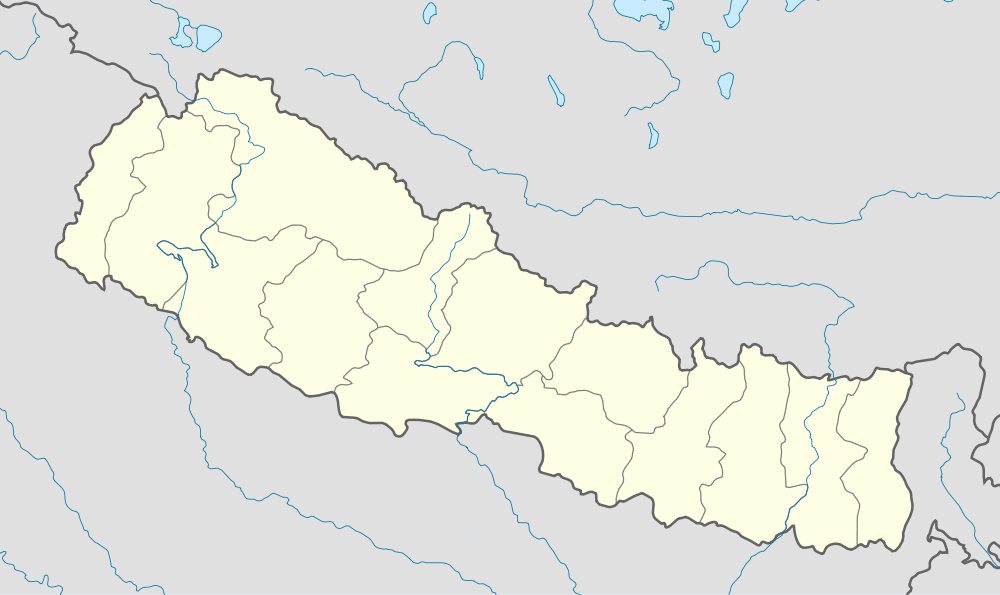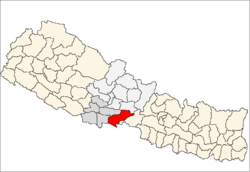Kumarwarti
| Kumarwarti कुमारवर्ती | |
|---|---|
| Village development committee | |
|
| |
 Kumarwarti Location in Nepal | |
| Coordinates: 27°36′N 84°6′E / 27.600°N 84.100°ECoordinates: 27°36′N 84°6′E / 27.600°N 84.100°E | |
| Country |
|
| Zone | Lumbini Zone |
| District | Nawalparasi District |
| Population (1991) | |
| • Total | 4,155 |
| Time zone | Nepal Time (UTC+5:45) |
Kumarwarti is a village development committee in Nawalparasi District in the Lumbini Zone of southern Nepal. At the time of the 1991 Nepal census it had a population of 4155 people living in 698 individual households.[1] However data derived more recently for marriage and education details has suggested in 2001 the population had grown to over 5000.[1]
History
On July 27, 2002, the Kathmandu Post reported that over 900 families in the Lumbini Zone area, including people from Kumarwarti had been displaced from their homes following flooding from the summer monsoon.[2] Then on November 15, 2006, it was reported that Kumarwarti VDC had been subject to attack by Maoist cadres who forcefully stole local farmers' rice.
Politics and conservation
The Village Development Committee is part of a protected environmental buffer zone in Nepal called the Royal Chitwan National Park (RCNP). Within the locality, politically, the VDC is under obligation to respect national Community Forestry guidelines.[3]
However, according to a 2003 Journal and Forest Livelihood report, Kumarwarti has been facing a leadership crisis since 2001, with several people from it failing to provide a committee in discussing protection in a reluctance to deal with the warden and National Park rangers.[3] The people of the Village Development Committee have been criticised for lacking the capacity to deal with the authorities, and to distance themselves away from management roles.[3]
In Kumarvarti, the sale of forest products is restricted within the buffer zone.[3] In 1998 when the poorer Majhi/Bote households wanted to sell their share of thatch grass to outside buyers for ₹3 per bundle to raise finances, they were denied permission by the authorities.[3]
Religion
The Village Development Committee is primarily Hindu in religion. However, the 2001 census recorded 82 Buddhists and 91 Christians living within it.[1]
Education
In 2001, 1802 out of 2212 of the people eligible for school were attending classes. 410 children were not receiving an education, 250 of these were female.[1] Kumarwarti has a number of schools including Kumarwarti English School, Kumarwarti Secondary School and Higher Secondary School/Kumarwarti College. Kumarwarti English School is located at27°40′57″N 84°13′51″E / 27.68250°N 84.23083°E. Rajendra K.C., currently a manager for the national Ideal Friendship-Nepal was previously a lecturer at Kumarwarti College for over two years.[4]
References
- 1 2 3 4 "Nepal Census 2001". Nepal's Village Development Committees. Digital Himalaya. Retrieved 18 December 2008.
- ↑ Kathmandu Post, July 27, 2002
- 1 2 3 4 5 Timsina, Netra; Paudel, Naya Sharma (2003). "State versus Community: A Confusing Policy Discourse in Nepal's Forest Management". Journal of Forest and Livelihood, University of Reading. www.forestaction.org. Archived from the original (PDF) on February 19, 2012. Retrieved 18 December 2008.
- ↑ "IDF Team". Ideal Friendship-Nepal. Archived from the original on November 19, 2008. Retrieved 18 December 2008.

